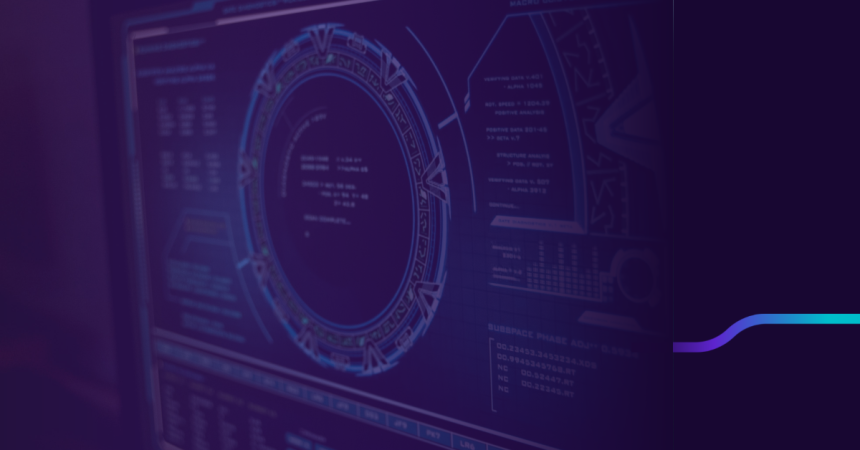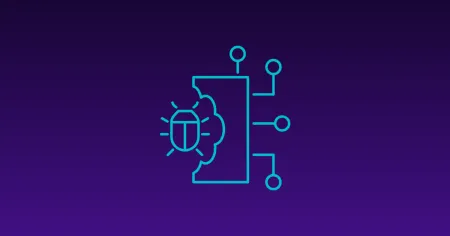Blog
Jan 30, 2024
What InfoSec Leaders Need to Know About AI
2024 sees AI reshaping cybersecurity. Leaders must grasp AI integration, secure tools, tackle emerging threats, and foster a culture of proactive, informed security.
7 min read

As 2024 unfolds, the cybersecurity realm is bracing for a seismic shift, predominantly fueled by the rapid evolution of Artificial Intelligence (AI). The rapid development of generative AI and pivotal research such as this recent arXiv research paper on AI underscore the profound impact AI is set to have in the field of cybersecurity. This blog post is designed to equip InfoSec leaders with actionable insights into the pivotal trends at the intersection of AI and cybersecurity, advocating a proactive and informed strategy essential for navigating today’s complex digital landscape, as it continues to be shaped by the introduction of AI tech.
The integration of AI in cybersec
AI’s role in cybersecurity is expanding from being a supportive tool to a core component of security strategies. Its capabilities in analyzing vast datasets for threat detection and automating routine tasks are indeed groundbreaking.
However, this integration is a double-edged sword. While AI can significantly enhance threat detection and predictive insights, it can also introduce risks, such as the potential exploitation of AI systems by adversaries. The rise of sophisticated tools like advanced cybersecurity-focused GPT wrappers and CrowdStrike’s Falcon has brought this reality to the forefront, with these tools being leveraged to create human-like text that can be used in phishing and social engineering attacks.
- Combat strategy: It’s crucial for organizations, and particularly InfoSec teams, to foster AI literacy, ensuring a profound understanding of AI’s capabilities and vulnerabilities. Conducting regular AI risk assessments and implementing robust AI security protocols guided by the findings of those assessments can mitigate potential threats. OffSec’s learning platform, constantly updated to reflect the latest trends and threats, can be instrumental in preparing your team to tackle these challenges head-on.
Securing AI tools: a paramount challenge
With 42% of enterprises now actively integrating AI into their operations, the focus on securing these technologies has never been more critical. The rapid adoption of AI tools brings to the forefront the paramount challenge of ensuring robust security measures. Recent trends underscore the urgency in addressing potential vulnerabilities that AI systems may encounter, such as model inversion, prompt injection, and data poisoning. Ensuring a secure AI environment requires a comprehensive and balanced strategy, where the benefits of AI are leveraged, while simultaneously mitigating its inherent risks.
Understanding Key Threats to AI Systems
Model inversion
This attack seeks to exploit AI models to reveal sensitive input data. Attackers use the model’s output to infer private information about the original dataset, posing risks to the privacy of the data used to train the model, which could in instances then be used to train other competitor models.
Prompt injection
This involves manipulating AI models, especially language models like GPT, by injecting crafted prompts to produce biased or malicious outputs. It’s a technique that can subtly sway the model’s behavior, leading to misinformation or unauthorized data access.
Data poisoning
In this attack, adversaries corrupt the training data of AI models, leading the model to make incorrect predictions or classifications. It’s a direct assault on the integrity of the model, aiming to skew its learning process and decision-making.
For InfoSec teams at organizations utilizing generative AI cross-functionally, understanding and mitigating these risks are crucial for harnessing AI’s power safely and effectively in cybersecurity tactics.
Democratization of AI: A catalyst for sophisticated attacks
The democratization of AI tools signifies a paradigm shift in the cybersecurity landscape. As these tools become more accessible, the capabilities they offer are no longer confined to a select few. This trend is escalating the prevalence of intricate attacks across different layers of the technology stack, encompassing firmware (notably via intelligent rootkits and smart infectious agents) and hardware (manifested through AI-powered fault injection and IoT adversarial machine learning). The need for InfoSec leaders to anticipate and prepare for these evolving threats has never been more critical.
- Combat strategy: Embrace a layered security approach, incorporating advanced threat detection systems and proactive incident response protocols. Engage in threat intelligence sharing platforms to gain insights into emerging threats and leverage AI-powered anomaly detection systems to identify and neutralize threats swiftly.
The evolving threat landscape: predictive analytics and AI
The threat landscape is becoming increasingly sophisticated, with attackers leveraging AI to devise more complex and stealthy attack vectors. In response, InfoSec teams must not only react to threats as they occur but also anticipate and neutralize them before they materialize. This is where predictive analytics and AI-driven threat intelligence come into play, offering the ability to forecast potential security incidents based on patterns and anomalies detected in data.
- Combat strategy: Invest in AI-powered threat intelligence platforms like IBM’s QRadar and Crowdstrike’s Falcon that provide real-time insights and predictive analytics. These tools can help your team identify potential threats before they escalate, allowing for preemptive action. Regularly train your team to interpret and act on the insights provided by these platforms, ensuring a proactive stance against emerging threats.
AI’s advancement is set to amplify the efficacy of phishing and social engineering attacks. The emergence of automated spear phishing and vishing tools, complemented by enhanced deep fake and voice cloning technology, is poised to significantly improve the success rates of these attacks. Consequently, organizations must focus on incorporating updated controls, awareness, and training to mitigate these enhanced methods.
- Combat strategy: Continue strengthening your human firewall by investing in regular cybersecurity awareness training. Simulate AI-driven phishing attempts to prepare your team for real-world scenarios. Implement strict verification processes and employ AI-based behavior analysis to detect and prevent fraudulent activities.
AI-powered vulnerability management: beyond traditional defenses
In the face of increasingly sophisticated cyber threats, traditional vulnerability management techniques may no longer suffice. AI-powered vulnerability management systems represent a significant leap forward, offering the ability to predict, prioritize, and patch vulnerabilities in real time. These systems leverage machine learning algorithms to analyze historical data, predict potential breach points, and suggest the most effective remediation strategies.
- Combat strategy: Integrate AI-powered vulnerability management tools into your cybersecurity framework. These tools can significantly enhance your ability to detect and address vulnerabilities before they are exploited by attackers. Encourage your team to engage with communities and forums where cybersecurity professionals discuss the latest AI tools and strategies. This will not only keep your team updated on the latest trends but also provide insights into the practical challenges and solutions encountered by peers in the industry.
Focusing on a culture of security and resilience
As AI technologies continue to permeate the cybersecurity landscape, fostering a culture of security and resilience within organizations becomes increasingly important. This involves not only equipping teams with the latest tools and technologies but also nurturing a mindset that values vigilance, adaptability, and continuous learning. InfoSec leaders should champion initiatives that promote security awareness across all levels of the organization, creating a unified front against potential threats.
- Combat strategy: Encourage cross-departmental collaboration and knowledge sharing sessions to ensure that every team member understands their role in maintaining the organization’s cybersecurity posture. Utilize platforms like OffSec’s interactive learning environments to provide hands-on experience with real-world scenarios, thereby enhancing the practical skills of your team.
Nurturing talent and expertise in AI security
As the demand for AI-driven security solutions grows, so does the need for skilled professionals who can effectively manage and leverage these technologies. InfoSec leaders must prioritize the development of talent within their teams, providing opportunities for continuous learning and growth in the realm of AI security.
- Combat strategy: Create pathways for professional development within your organization, offering access to advanced training and certification programs like those offered by OffSec. Encourage your team to stay abreast of the latest developments in AI security by participating in industry conferences, webinars, and workshops. Foster an environment that supports experimentation and innovation, allowing team members to explore new AI-driven security solutions and methodologies.
Embracing proactive security measures
Rapid advancements in the field of machine learning and artificial intelligence underscore the importance of adopting proactive security tools and technologies. As threat actors refine their tactics, leveraging standardized attack techniques, the speed and efficacy of cybersecurity measures to defend, detect, and mitigate threats become paramount. Investing in tools for risk-based vulnerability management, attack surface management, and security posture management is essential in staying ahead of potential breaches.
The critical role of continuous learning and adaptation
The dynamic nature of cybersecurity, especially in the context of rapid adoption and advancement in the field of AI and ML, necessitates a commitment to continuous learning and adaptation. InfoSec teams must remain vigilant, continuously updating their knowledge and skills to keep pace with the rapidly evolving threat landscape. Engaging in continuous professional development, through platforms like OffSec’s diverse learning platform, ensures that your team remains at the cutting edge of cybersecurity expertise.
Equip your team with a clear, base-level understanding of AI’s role in cybersecurity with OffSec’s first AI module, designed for learners with an active subscription. The module offers a concise journey through the essentials and offers:
- The evolution from early AI developments to contemporary applications.
- Insights into AI’s integration within the cybersecurity landscape.
Explore this module for a comprehensive yet succinct understanding, empowering your team to navigate the complexities of AI in cybersecurity effectively.
Stay in the know: Become an OffSec Insider
Get the latest updates about resources, events & promotions from OffSec!
Latest from OffSec

Research & Tutorials
CVE-2024-13059: Exploiting Path Traversal in AnythingLLM for Remote Code Execution
Discover CVE-2024-13059, a critical vulnerability flat that affects AnythingLLM’s handling of ASCII filenames in the multer library.
Apr 17, 2025
2 min read

Enterprise Security
How OSCP Holders Can Lead Their Teams to Greater Cybersecurity Resilience
Champion OSCP training in your organization to build a unified, resilient security team.
Apr 11, 2025
6 min read

Research & Tutorials
CVE-2024-57727: Path Traversal Vulnerability in SimpleHelp Web Application
CVE-2024-57727 lets attackers read sensitive files via path traversal in SimpleHelp. Learn more about how attackers exploit this flaw.
Apr 10, 2025
3 min read